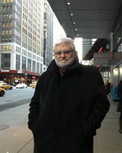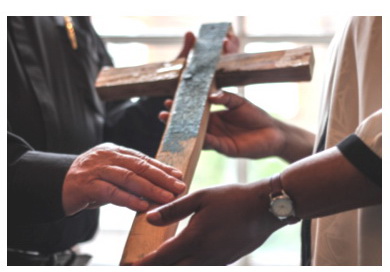 Chris
McDonnell, UK
Chris
McDonnell, UK
chris@mcdonnell83.freeserve.co.uk
Previous articles by Chris Comments
welcome here
July
19, 2017
The
wood of the Cross

Signs
and symbols are important. They carry memory of times and places of
significance. They tell a story.
During
a massive air raid on the city of
Coventry
in November 1940, the medieval cathedral was
destroyed, the wooden rafters of the roof collapsing in the fire that
ensued. Only the outer shell of stone walls remained.
In
the days that followed, hundreds of nails that secured the roofing beams
were collected from the floor, later to be formed in to Crosses of
Remembrance and distributed world wide. Out of an act of war came an act
of forgiveness and memory.
In
our own time something similar has occurred. During the last three years
we have heard countless stories of loss, of refugees lost in the
Mediterranean
as their over-loaded ships broke up and sank.
An
island off the south coast of
Italy
became a place of landfall for those who somehow
survived, drifting ashore on timber from the wrecked boats. Lampedusa
became known for the care it gave to so many. It was visited by Francis
very soon after his election to the See of Rome when he celebrated the
Eucharist in a field near the
Island
’s port. It was his first visit outside of
Rome
as Bishop. He spoke with the people during his sermon
saying "We have become used
to other people's suffering, it doesn't concern us, it doesn't interest
us, it's none of our business!"
Yet, of course it is. His altar on that occasion was constructed from an
old fishing boat painted in
Italy
's red, green and white
national colors.
Their
journey had arisen from persecution and poverty in their homelands. They
were willing to risk all for a better, safer future for their families.
Caring for them within the EU became a huge task, for while some countries
offered help and hospitality, others were reluctant to accept an influx of
immigrants. The immensity of
the task was overwhelming giving rise to considerable anxiety and
confusion.
One
man decided to help in a small yet significant way. He was a resident of
Lampedusa, a carpenter by the name of Francesco Tuccio.
As the drift wood from the wrecked boats came ashore with the tide,
he began collecting the torn and splintered material, peeling paint work
revealing the original natural wood. From this salvage he began fashioning
simple crosses, leaving the original scarred finish from the time at sea.
Pope
Francis carried one of the Tuccio crosses at the memorial Mass to
commemorate people who had died. Those who survived the Crossing were also
given one as a sign of hope.
In
consequence of the work of Francesco Tuccio, CAFOD distributed one of the
Crosses to every Cathedral in
England
and
Wales
. It was when visiting the parish
of St Gregory in Stratford-on-Avon recently that I saw one of these
crosses stood on the sanctuary during mass, a silent icon of memory and
hope.
The
British
Museum
in
London
has also received a Lampedusa
Cross made from pieces of a boat that was
wrecked off the coast of
Lampedusa
, on 11 October, 2013.
The
British
Museum
web site records that
‘…the cross piece retains scuffed blue paint on the front, upper and
lower surfaces. The front of the vertical section has layers of damaged
paint. The base coat is dark green which was covered with a beige colour
then painted orange. The sides and back are planed down to the timber
surface. There is a small hole for suspension on the back of the vertical
near the top. A fragment of an iron nail survives at the top in the right
side of the cross piece. The back of the cross piece is signed F. Tuccio,
Lampedusa’
It
measures some 38 cm in height and 28 cm in width. .
The
text further notes that ‘Mr Tuccio
kindly made this piece for the
British
Museum
to mark an
extraordinary moment in European history and the fate of Eritrean
Christians. It also stands witness to the kindness of the people of the
small
island
of
Lampedusa
who have done
what they can for the refugees and migrants who arrive on their shores’
Like
the cathedral in
Coventry
, the
island
of
Lampedusa
has marked tragedy with a gift made from wreckage, the
left-over materials from conflict. Those small gifts from both locations
have been offered round the world as tokens of memory to help with peace
and reconciliation between peoples.
The
twisted nails from the burnt roofing timbers of the cathedral, the wasted
wooden remains of broken boats, each in their own way form a gift of hope.
They are small tokens which carry immense meaning that we shouldn’t
ignore and must not forget.
END
----------------------
 Chris
McDonnell, UK
Chris
McDonnell, UK Chris
McDonnell, UK
Chris
McDonnell, UK